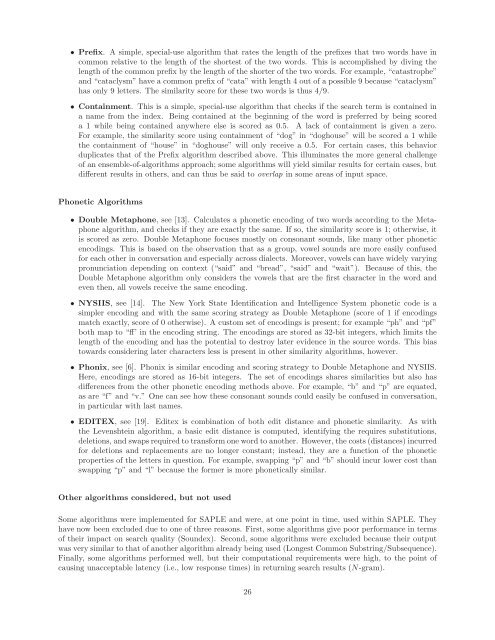SAPLE: Sandia Advanced Personnel Locator Engine - Mike Procopio
SAPLE: Sandia Advanced Personnel Locator Engine - Mike Procopio
SAPLE: Sandia Advanced Personnel Locator Engine - Mike Procopio
You also want an ePaper? Increase the reach of your titles
YUMPU automatically turns print PDFs into web optimized ePapers that Google loves.
• Prefix. A simple, special-use algorithm that rates the length of the prefixes that two words have in<br />
common relative to the length of the shortest of the two words. This is accomplished by diving the<br />
length of the common prefix by the length of the shorter of the two words. For example, “catastrophe”<br />
and “cataclysm” have a common prefix of “cata” with length 4 out of a possible 9 because “cataclysm”<br />
has only 9 letters. The similarity score for these two words is thus 4/9.<br />
• Containment. This is a simple, special-use algorithm that checks if the search term is contained in<br />
a name from the index. Being contained at the beginning of the word is preferred by being scored<br />
a 1 while being contained anywhere else is scored as 0.5. A lack of containment is given a zero.<br />
For example, the similarity score using containment of “dog” in “doghouse” will be scored a 1 while<br />
the containment of “house” in “doghouse” will only receive a 0.5. For certain cases, this behavior<br />
duplicates that of the Prefix algorithm described above. This illuminates the more general challenge<br />
of an ensemble-of-algorithms approach; some algorithms will yield similar results for certain cases, but<br />
different results in others, and can thus be said to overlap in some areas of input space.<br />
Phonetic Algorithms<br />
• Double Metaphone, see [13]. Calculates a phonetic encoding of two words according to the Metaphone<br />
algorithm, and checks if they are exactly the same. If so, the similarity score is 1; otherwise, it<br />
is scored as zero. Double Metaphone focuses mostly on consonant sounds, like many other phonetic<br />
encodings. This is based on the observation that as a group, vowel sounds are more easily confused<br />
for each other in conversation and especially across dialects. Moreover, vowels can have widely varying<br />
pronunciation depending on context (“said” and “bread”, “said” and “wait”). Because of this, the<br />
Double Metaphone algorithm only considers the vowels that are the first character in the word and<br />
even then, all vowels receive the same encoding.<br />
• NYSIIS, see [14]. The New York State Identification and Intelligence System phonetic code is a<br />
simpler encoding and with the same scoring strategy as Double Metaphone (score of 1 if encodings<br />
match exactly, score of 0 otherwise). A custom set of encodings is present; for example “ph” and “pf”<br />
both map to “ff’ in the encoding string. The encodings are stored as 32-bit integers, which limits the<br />
length of the encoding and has the potential to destroy later evidence in the source words. This bias<br />
towards considering later characters less is present in other similarity algorithms, however.<br />
• Phonix, see [6]. Phonix is similar encoding and scoring strategy to Double Metaphone and NYSIIS.<br />
Here, encodings are stored as 16-bit integers. The set of encodings shares similarities but also has<br />
differences from the other phonetic encoding methods above. For example, “b” and “p” are equated,<br />
as are “f” and “v.” One can see how these consonant sounds could easily be confused in conversation,<br />
in particular with last names.<br />
• EDITEX, see [19]. Editex is combination of both edit distance and phonetic similarity. As with<br />
the Levenshtein algorithm, a basic edit distance is computed, identifying the requires substitutions,<br />
deletions,andswapsrequiredtotransformonewordtoanother. However,thecosts(distances)incurred<br />
for deletions and replacements are no longer constant; instead, they are a function of the phonetic<br />
properties of the letters in question. For example, swapping “p” and “b” should incur lower cost than<br />
swapping “p” and “l” because the former is more phonetically similar.<br />
Other algorithms considered, but not used<br />
Some algorithms were implemented for <strong>SAPLE</strong> and were, at one point in time, used within <strong>SAPLE</strong>. They<br />
have now been excluded due to one of three reasons. First, some algorithms give poor performance in terms<br />
of their impact on search quality (Soundex). Second, some algorithms were excluded because their output<br />
was verysimilar to that ofanother algorithm alreadybeing used (LongestCommon Substring/Subsequence).<br />
Finally, some algorithms performed well, but their computational requirements were high, to the point of<br />
causing unacceptable latency (i.e., low response times) in returning search results (N-gram).<br />
26
















